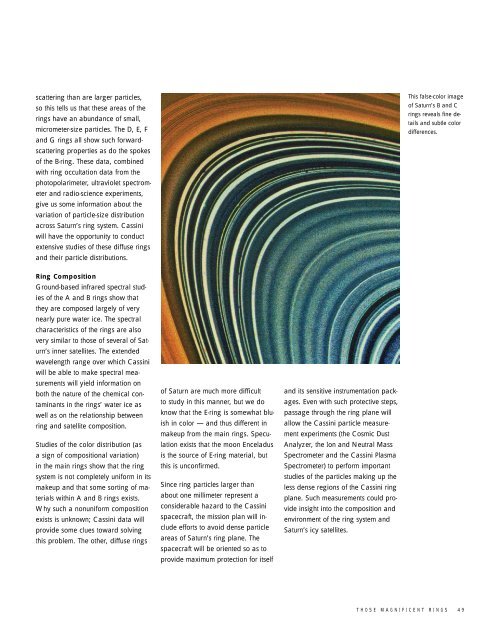Passage to a Ringed World - NASA's History Office
Passage to a Ringed World - NASA's History Office
Passage to a Ringed World - NASA's History Office
Create successful ePaper yourself
Turn your PDF publications into a flip-book with our unique Google optimized e-Paper software.
scattering than are larger particles,<br />
so this tells us that these areas of the<br />
rings have an abundance of small,<br />
micrometer-size particles. The D, E, F<br />
and G rings all show such forwardscattering<br />
properties as do the spokes<br />
of the B-ring. These data, combined<br />
with ring occultation data from the<br />
pho<strong>to</strong>polarimeter, ultraviolet spectrometer<br />
and radio-science experiments,<br />
give us some information about the<br />
variation of particle-size distribution<br />
across Saturn’s ring system. Cassini<br />
will have the opportunity <strong>to</strong> conduct<br />
extensive studies of these diffuse rings<br />
and their particle distributions.<br />
Ring Composition<br />
Ground-based infrared spectral studies<br />
of the A and B rings show that<br />
they are composed largely of very<br />
nearly pure water ice. The spectral<br />
characteristics of the rings are also<br />
very similar <strong>to</strong> those of several of Saturn’s<br />
inner satellites. The extended<br />
wavelength range over which Cassini<br />
will be able <strong>to</strong> make spectral measurements<br />
will yield information on<br />
both the nature of the chemical contaminants<br />
in the rings’ water ice as<br />
well as on the relationship between<br />
ring and satellite composition.<br />
Studies of the color distribution (as<br />
a sign of compositional variation)<br />
in the main rings show that the ring<br />
system is not completely uniform in its<br />
makeup and that some sorting of materials<br />
within A and B rings exists.<br />
Why such a nonuniform composition<br />
exists is unknown; Cassini data will<br />
provide some clues <strong>to</strong>ward solving<br />
this problem. The other, diffuse rings<br />
of Saturn are much more difficult<br />
<strong>to</strong> study in this manner, but we do<br />
know that the E-ring is somewhat bluish<br />
in color — and thus different in<br />
makeup from the main rings. Speculation<br />
exists that the moon Enceladus<br />
is the source of E-ring material, but<br />
this is unconfirmed.<br />
Since ring particles larger than<br />
about one millimeter represent a<br />
considerable hazard <strong>to</strong> the Cassini<br />
spacecraft, the mission plan will include<br />
efforts <strong>to</strong> avoid dense particle<br />
areas of Saturn’s ring plane. The<br />
spacecraft will be oriented so as <strong>to</strong><br />
provide maximum protection for itself<br />
and its sensitive instrumentation packages.<br />
Even with such protective steps,<br />
passage through the ring plane will<br />
allow the Cassini particle measurement<br />
experiments (the Cosmic Dust<br />
Analyzer, the Ion and Neutral Mass<br />
Spectrometer and the Cassini Plasma<br />
Spectrometer) <strong>to</strong> perform important<br />
studies of the particles making up the<br />
less dense regions of the Cassini ring<br />
plane. Such measurements could provide<br />
insight in<strong>to</strong> the composition and<br />
environment of the ring system and<br />
Saturn’s icy satellites.<br />
This false-color image<br />
of Saturn’s B and C<br />
rings reveals fine details<br />
and subtle color<br />
differences.<br />
THOSE MAGNIFICENT RINGS 49
















